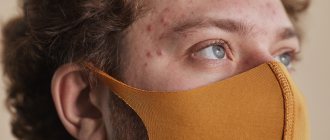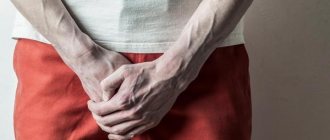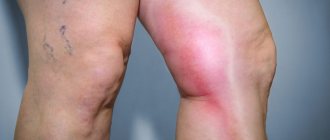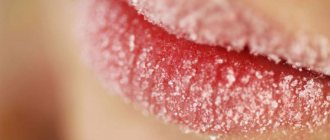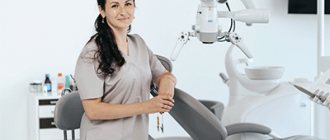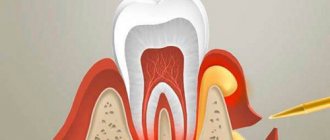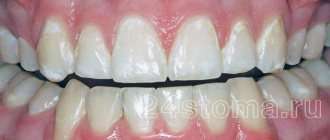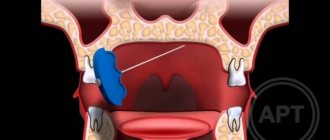This is a fairly rare disease that affects men between 30 and 60 years of age who are sexually active. At this age, the genital organ is more susceptible to microtrauma, including during sex. In men over 60, the disease is rare due to decreased sexual activity. The disease is named after the man who first described it in 1743. During Peyronie's disease, a man's penis becomes curved due to progressive fibrotic changes in its tunica albuginea.
Peyronie's disease (normal and curvature)
Photo: Patient with Peyronie's disease (Source: ru.wikipedia.org)
Nature and causes of Peyronie's disease
For a long time, experts believed that Peyronie's disease was endocrine in nature, and therefore they tried to treat the disease using hormones from the pituitary gland, adrenal glands and parathyroid glands. However, subsequently, experts increasingly began to be inclined to believe that the curvature of the penis is caused by injuries, for example, during forced sexual intercourse.
Among the reasons are the following:
- a wide range of injuries to the genital organ, for example, during sexual intercourse, from a blow or an accidental fall on a hard surface;
- microtraumas that are invisible to the eye and not accompanied by pain. They often occur during sexual intercourse;
- closed fracture of the penis, in which the integrity of the skin is not violated, but hemorrhage occurs;
- abnormalities of the immune system;
- diabetes;
- taking medications;
- the presence of narrowing of the lumen of blood vessels, which is characteristic of a disease such as atherosclerosis;
- a wide range of connective tissue diseases;
- gout – an increase in the level of uric acid in the blood;
- deficiency of vitamin E and calcium in the body;
- increased levels of serotonin in the body;
- the man's age. As the body ages, tissues lose their elasticity and are more susceptible to injury.
The role of a hereditary factor in the genesis of Peyronie's disease cannot be excluded. At a minimum, this is evidenced by Dupuytren's contracture, which occurs in more than half of patients with Peyronie's pathology.
Classification and types of disease
Peyronie's disease can lead to three types of penile curvature: dorsal, ventral, lateral. In the first case, the penis in men “looks” upward; with ventral deviation, it is directed downward, and with lateral deviation, the lateral deformation of the penis is called. Treatment is not required if the curvature is mild, is not associated with pain and does not interfere with sexual intercourse.
Depending on the stage of its progression, Peyronie's disease is divided into:
- pain – men complain of severe pain not only during an erection, but also at rest. Only in isolated cases does the manifestation of pain not bother men, and the reason for contacting a doctor is a well-palpable plaque. Often its size does not exceed two centimeters;
- functional - in addition to causing pain, such an illness leads to the inability to lead a normal sexual life.
Since Peyronie's disease has a very high tendency to progress, self-diagnosis and, especially, self-medication are unacceptable here. If pain occurs in the head and body of the penis, you should immediately consult a urologist. Only at this stage is consultation with this specialist effective and can prevent the disease.
Diagnosis and treatment
Diagnosing diseases is not difficult. The doctor conducts a visual examination and palpates the scrotum. And just one examination is often enough to suggest an accurate diagnosis. But to confirm it, Doppler ultrasound is used; additional tests for infections, as well as general blood and urine tests, are prescribed.
Treatment of orchitis and epididymitis is conservative. A swab is taken from the man's urethra to determine the type of infection. You can also additionally analyze the sensitivity of pathogenic flora to antibiotics. Antibiotics are the main treatment in this case.
Since an acute process can easily develop into a chronic one, in no case should you prescribe treatment for yourself. An incorrectly selected antibiotic or incorrect dosage can lead to false relief and subsidence of symptoms. A man will think that he is completely healthy, but in fact, orchitis and epididymitis will simply turn into a chronic, blurred form. Constantly inflamed glands stop functioning normally, and sometimes a man may even develop infertility. In advanced cases, doctors have to resort to surgery, but this can be completely avoided. Therefore, at the first signs of illness you should consult a doctor. High-quality diagnostics and treatment can be obtained at the Dr. AkNer.
How dangerous is the disease? Symptoms of Peyronie's disease
Peyronie's disease is dangerous not only because it leads to curvature of the penis. The progressive development of fibrous plaques causes pain during erection, which makes sexual intercourse impossible. Ultimately, Peyronie's disease leads to the development of erectile dysfunction.
The most common symptoms of Peyronie's disease are:
- Pain in the penis during erection (enlargement and tension of the penis during sexual arousal).
- Curvature of the penis to the side, to the side of the abdomen, towards the sac.
- The presence of a compacted area under the skin of the penis.
- Deterioration of erection. During sexual arousal, the penis does not enlarge and does not harden to the required volume.
- Functional shortening of the penis. A decrease in the size of the penis is not due to a decrease in length, but to its curvature.
What can cause a testicle to increase in size?
The average width of the testicles varies from 2.5 to 3.5 cm, length - from 4 to 6 cm. Normally, one is located slightly higher than the other, which is due to physiology: different origins of the arteries of the testicles, as well as the need to protect the testicles from injury and overheating due to the tight fit. Possible causes of testicular enlargement include:
- benign tumors;
- malignant tumors;
- varicocele;
- testicular torsion;
- hernia in the groin;
- epididymitis.
Benign tumors
One of the causes of swollen testicles in men is benign neoplasms. They are typical for middle age. The tumor can be felt independently, most often on the back surface of the testicle. There may be several neoplasms; they can be located on both sides of the testicle. There are several types of tumors:
- Spermatocele. A cyst of the testicle or epididymis filled with liquid contents. The main symptom of spermatocele is testicular enlargement without pain or disorders of the reproductive system. Therefore, a common cause of testicular enlargement in men, if there is no pain, is precisely a cystic formation. Discomfort appears only when the cyst enlarges greatly, which can cause discomfort when sitting, walking and sexual intercourse.
- Hydrocele (dropsy of the testicles). It is an accumulation of fluid in the area of the scrotum and testicular membranes. In adults, hydrocele is more common between the ages of 20 and 40 years. It may appear after injury or infection. The tumor can be felt by palpation.
- Hematocele. The tumor forms when blood cells accumulate in the membranes of the testicles. Hematocele can accompany injuries and malignant tumors. Over time, it becomes denser and thicker.
Varicocele
An enlarged testicle can also cause varicocele - varicose veins of the spermatic cord. It is most often encountered by men aged 17-30 years. In 80% of cases, varicocele causes enlargement of the left testicle in men. Varicose veins on the right testicle occur in 2-12% of cases, and bilateral veins - in 3-8%.
Malignant tumors
A common cause of testicular enlargement in older men is a malignant tumor, lymphoma. The average age for such a diagnosis is 67 years. In the age group over 60 years, this disease is quite common. Risk factors include autoimmune diseases, weakened immunity, viral infections, and previous chemotherapy or radiation therapy.
Other types of malignant tumors are more common in mature men 20-40 years old. The disease is accompanied by severe pain. Another characteristic sign is blood in the semen. These manifestations are accompanied by other symptoms that are characteristic of cancer: weakness in the body, low-grade fever, increased fatigue, and enlarged lymph nodes. It is important to start dealing with the causes and treatment of testicular swelling as early as possible, since with early treatment, complete recovery is observed in 90% of cases.
Testicular torsion
When the spermatic cord is twisted, the blood vessels are pinched, the scrotum swells, and becomes reddish or bluish. The man experiences nausea and vomiting, as well as excruciating pain in the scrotum. With testicular torsion, even fainting is possible.
Hernia in the groin
An inguinal hernia occurs due to intense physical activity and heavy lifting. As a result, one or more loops of the large intestine prolapse into the lumen of the inguinal canal. A characteristic sign of a hernia is that when lying down, the intestine returns to its place, so the problem is temporarily solved. A hernia can cause an enlarged right or left testicle in men. From which side the intestine prolapses, swelling is observed.
Epididymitis
Epididymitis is inflammation of the epididymis. It can be encountered at any age. The disease is associated with infection, hypothermia, urological diseases, physical overexertion, promiscuity, and horse riding. The disease is characterized by severe pain in the testicles, radiating to the abdomen, groin, perineum and lower back. The temperature rises to 38-39 °C, the scrotum turns red and swells, and a feverish state is observed.
Diagnosis of Peyronie's disease
As a rule, the characteristic clinical picture of the disease and the presence of an inflammatory process of the penis in the anamnesis do not leave any questions about the diagnosis. For more accurate information about the number, location and structure of plaques, instrumental research methods are used. The results of ultrasound and radiography can become irreplaceable information when choosing the volume and method of surgery.
What exactly and how does a urologist andrologist check? Let's take a closer look. First of all, information is collected regarding the time of onset of the first symptoms of the disease and previous illnesses of both the patient and his immediate family. This is done to identify the cause of the expression or confirmation of a hereditary factor. Next, the patient fills out specially designed tests aimed at determining the quality of sexual life; direct examination by a urologist of the genital organ in a state of erection. This process will be accelerated if the patient himself brings a photo of the penis in different projections. An ultrasound of the vessels of the penis is prescribed - it is carried out to assess blood circulation in the area of the lump. If necessary, an MRI of the genital organ is performed - the technique makes it possible to obtain a layer-by-layer image of the tissues of the organ. This is the most informative diagnostic method, allowing you to determine the location of the plaque and its volume. Cavernosography is the introduction of a special contrast agent into the internal structures of the penis and radiography.
Symptoms of acute orchitis and epididymitis
If the testicle and its appendage become inflamed for the first time, we are talking about an acute process. The symptoms of acute orchitis and epididymitis are similar. A man may experience:
- general malaise - weakness, loss of appetite, decreased ability to work;
- headache;
- increased body temperature, sometimes to very high values;
- pain in the perineum and scrotum, which can radiate to the tailbone, groin and lower back;
- redness and swelling on the side of the affected testicle.
It is the typical symptoms of scrotal diseases, that is, changes in size, redness and pain in the organ, that can become an indicator of orchitis and epididymitis. The remaining symptoms are not specific and may indicate other diseases.
Prevention of Perioni's disease
Since the exact causes of the disease are still unknown, it is difficult to offer specific prevention of Peyronie’s disease. However, men are advised to adhere to a certain lifestyle to minimize the occurrence of the disease.
- Healthy lifestyle (healthy diet, exercise, regular checkups).
- Wear comfortable underwear and loose pants.
Article information
| Last update | April 21, 2021 |
| Next update | April 21, 2022 |
| Author | Potapov S.A. |
| Medical editor | Doctor Plekhanov A.Yu. |
Bibliography
- Guidelines on Penile Curvature; European Association of Urology (2015)
- Bilgutay AN, Pastuszak AW; Peyronie's Disease: a Review of Etiology, Diagnosis and Management. Curr Sex Health Rep. 2015 Jun 17(2):117-131. doi: 10.1007/s11930-015-0045-y.
- Gelbard MK, et al. The natural history of Peyronie's disease. J Urol 1990 144(6): p. 1376-9.
- Jarow JP, et al. Penile trauma: an etiologic factor in Peyronie's disease and erectile dysfunction. J Urol 1997 158(4): p. 1388-90.
It is known that one of the factors in the development of cancer is nutrition. Therefore, it is necessary to pay attention to all meals throughout the day, starting with breakfast. Today we will talk about foods that provoke the division of cancer cells.
Three food categories that are not suitable for morning meals
Fried foods are class 2A carcinogens
Fried pies, onion cakes, deep-fried wings, and hamburgers are some of the favorite foods most people eat for breakfast. However, foods fried in oil are classified as Class 2A carcinogens.
When frying foods at high temperatures, not only the vitamins and nutrients that make up them are destroyed, but also high-temperature denaturation of proteins and fats occurs, which results in the formation of carcinogens such as benzopyrene and heterocyclic amines.
Thus, when frying in oil at high temperatures, many healthy and nutritious foods instantly become a source of dangerous carcinogens that cause cancer. An example is chicken eggs. This is an ideal breakfast product. However, fried eggs can acquire carcinogenic properties. Eating fried eggs in large quantities can contribute to the development of cancer. Therefore, those who like to eat chicken eggs for breakfast are advised to choose healthier cooking methods, such as boiling.
Your morning meal must include vegetables or fruits. Fried pies with soy milk (One of the most common breakfasts in China. - Note by InoSMI) are recommended to be consumed no more than once a week. Also, on days when you decide to indulge in fried foods for breakfast, try to avoid fried foods for lunch or dinner.
Pickles are class A2 carcinogens
The World Health Organization's International Agency for Research on Cancer recently added pickled foods to its official list of carcinogens.
Salted vegetables and pickled foods contain large amounts of nitrites. Although nitrites themselves do not cause cancer, when they combine with the products of protein decomposition in the stomach, they contribute to the formation of carcinogenic substances - nitrosamines.
Of course, you shouldn’t completely exclude pickles from your diet, but frequent consumption of them can lead to oncology.
Meat products are class 1 carcinogens
Processed meat products include ham, sausages, bacon, dried and smoked meats, and canned meats. The main health hazard of such products is their sodium nitrite content.
Back in 2016, the World Health Organization listed processed meat products as a Class 1 carcinogen, that is, products that are likely to cause cancer.
To prevent the division of cancer cells, it is necessary to take care of the blood vessels of the brain. Nutrition also plays an important role in this matter. In this case, what should a proper breakfast consist of?
WeChat 10/17/2020 Dnieper panorama 03/17/2020 Focus 10/27/2021
Five components of a perfect breakfast
A bowl of oatmeal
Oatmeal is called “longevity porridge.” To double the beneficial effect, you can mix oats with millet. This porridge has a pleasant aroma and delicate taste. It helps reduce blood sugar and lipid levels, and also has a beneficial effect on the gastric mucosa.
One egg
Eggs are a food with high nutritional value. Various studies by nutritionists and medical experts in China and other countries have shown that eating one egg a day reduces the risk of developing many serious diseases.
A glass of milk
According to the Dietary Guidelines for Chinese Residents, it is recommended to consume milk and dairy products daily. A glass of milk for breakfast helps replenish calcium and vitamins necessary for the body. And for middle-aged and elderly people, drinking one glass of milk in the morning is an excellent way to prevent the development of atherosclerosis, hypertension and osteoporosis.
One vegetable or fruit
The study found that people who consumed more than 569 grams of vegetables and fruits daily had a 10% lower risk of early death than those who consumed less than 249 grams per day. In addition, for every 200 gram increase in the consumption of vegetables and fruits, the risk of early death decreases by another 6%.
Eating one vegetable or fruit for breakfast can reduce morbidity and mortality from cardiovascular disease, reduce stress and increase life expectancy.
Handful of nuts
Most people eat too little food for breakfast, which means they don't get enough nutrients. Adding high-energy foods such as nuts to your diet will help solve this problem. This will improve the quality of breakfast and correctly distribute calorie intake within three meals a day.
According to an American study, the daily intake of almonds, walnuts and other types of nuts is 28 grams, that is, one handful.
What else should you pay attention to?
It is recommended to eat hot food for breakfast
In the morning, the air temperature is quite low, and a person’s muscles, nerves and blood vessels are in an “unheated” state. Therefore, eating cold food can negatively affect blood circulation.
The best time for breakfast is from seven to eight in the morning
According to medical research, the most optimal time for breakfast is between seven and eight in the morning, since during this period people have the highest appetite. Try to spend 15-20 minutes on breakfast and follow the correct work and rest schedule.
You shouldn't eat on the go
Office workers often eat breakfast on the way to work. But in fact, such a breakfast is a health risk, since dust, harmful microorganisms and gases contained in the air enter the body along with food.
The interval between breakfast and lunch should be four to five hours. If you find yourself having to eat breakfast too early, increase the size of your breakfast accordingly or plan an earlier lunch.
InoSMI materials contain assessments exclusively of foreign media and do not reflect the position of the InoSMI editorial staff.
